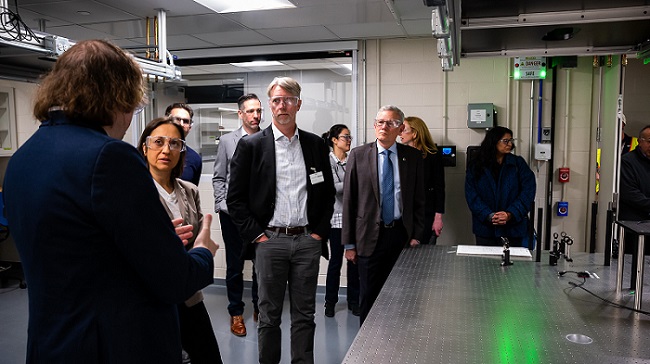LEMONT, Ill., May 15, 2023 — Argonne National Laboratory has opened its Quantum Foundry, part of the U.S. Department of Energy’s (DOE) drive to accelerate advancements in quantum information science. The Argonne Quantum Foundry is part of Q-NEXT, one of five DOE Office of Science National Quantum Information Science Research Centers.
The center is designed to meet critical needs in quantum science by providing a robust national supply chain of materials for quantum devices and systems. Primarily, the foundry will be focused on the development of atomic defect-based qubits — often referred to as spin qubits — in wide bandgap materials.
“We are interested in defects such as the nitrogen-vacancy center in diamond, which consists of a missing atom (vacancy) next to a substitutional nitrogen atom in an otherwise perfect diamond lattice,” said Joseph Heremans, staff scientist at Argonne National Laboratory. “The atomic-scale defect provides isolation for a ‘trapped’ electron that serves as our qubit and allows us to exploit the underlying quantum physics of the system.”

Argonne scientist Joseph Heremans gives a tour of the Argonne Quantum Foundry to guests at the ribbon cutting. Courtesy of Argonne National Laboratory.
The foundry aims to develop a number of suitable combinations of defects and host materials, including diamond, silicon carbide, and oxides. These spin qubits are being developed for technologies such as quantum sensing and quantum communication.
“Our goal is to create spin qubits deterministically within well-localized spots in a scalable manner,” Heremans said. “If successful, this could enable some fundamental advances in chip-scale entanglement and quantum interconnects.”
The current focus is to develop solid-state materials for quantum sensing and quantum communication, but if the researchers can sufficiently develop the materials platform, there are potential scalable approaches to quantum computing as well, Heremans said.
Argonne National Laboratory is currently undertaking major work at its Advanced Photon Source (APS), performing a long-scheduled upgrade. In anticipation of this, the team was able to conduct a number of valuable experiments prior to the APS’ scheduled shutdown.
“Additional experiments during the APS upgrade will be performed at other synchrotrons and x-ray facilities around the world, including the Stanford Synchrotron Radiation Lightsource (SSRL) and the Linac Coherent Light Source (LCLS-II) at SLAC National Accelerator Laboratory,” Heremans said. “However, we are eagerly awaiting the APS-U, which should allow us to leverage the increased brightness to further understand the fundamental material properties of our systems at an unparalleled scale.”
Q-NEXT is also developing another quantum foundry at SLAC National Accelerator Laboratory known as the Detector Microfabrication Facility (DMF), which will focus more on superconducting devices and detectors.
The Quantum Foundry and the partner foundry at SLAC will support Q-NEXT partners and the broader academic and industrial quantum ecosystem, Heremans said. The goal is to develop standardized semiconducting and superconducting qubit materials and devices in support of Q-NEXT missions. As part of that mission, Argonne and SLAC intend to train quantum scientists and engineers on the sample preparation, materials synthesis, nanofabrication, and characterization techniques required to develop scalable quantum technologies.
“Additionally, we are eager participants in a wide variety of internship programs, such as the Open Quantum Initiative led by the Chicago Quantum Exchange and the Science Undergraduate Laboratory Internship program sponsored by the Department of Energy, developing much needed exposure to quantum science while providing opportunities and training for young scientists and engineers,” Heremans said.